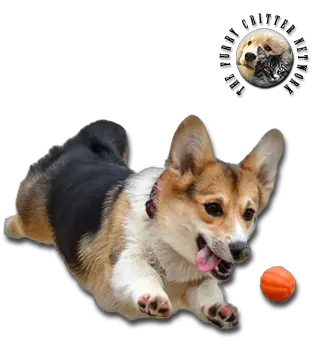Breed Standard
Head: Foxy in shape and appearance. Broad, flat skull. Stop not pronounced. Tapered muzzle.
Ears: Held erect. Moderately long, rounded at the tips.
Eyes: Medium size, round. Variations of brown in harmony with the coat color.
Body: The Cardigan is larger than the Pembroke, but his chest is not as broad. Belly slightly tucked up. Straight back.
Tail: Cardigan: relatively long, richly clad, carried low at rest. Pembroke: naturally short or docked at birth.
Hair: Cardigan: short or medium length, harsh and straight; short, thick undercoat. Pembroke: medium length, straight, thick, neither harsh nor soft; dense undercoat.
Coat: Cardigan: all colors acceptable, with or without white markings, but white must not be dominant color. Pembroke: self colors—red, sable, fawn, tan—with or without white markings on the legs, forechest, neck, and head.
Size: Cardigan: approx. 30 cm.Pembroke: 25 to 30 cm.
Weight: Cardigan: 12 to 15 kg.Pembroke: Dog: 10 to 12 kg; Bitch 10 to 11 kg.
History
The Pembroke Welsh Corgi lineage has been traced back as far as 1107 AD. It is said that Flemish weavers brought the dogs with them as they traveled to reside in Wales. Ancient lore states that two children were running through a forest and stumbled upon the funeral of a fairy. The mourning fairies gave the two children two small corgi puppies and the children took them home, thus giving the breed popularity. Stories also state that Corgis played the role of war horses for fairies before they became herding dogs for humans. At the base of the haunches of Corgis, there is a line of slightly rougher fur that ancient Welsh lore states is the saddle line from fairy warriors.
Pembrokes and Cardigans first appeared together in 1925 when they were shown under the rules of The Kennel Club in Britain. The Corgi Club was founded in December 1925 in Carmarthen, Carmarthenshire. It is reported that the local members favored the Pembroke breed, so a club for Cardigan enthusiasts was founded a year or so later. Both groups have worked hard to ensure the appearance and type of breed are standardized through careful selective breeding. Pembrokes and Cardigans were officially recognized by the Kennel Club in 1928 and were initially categorized together under the single heading of Welsh Corgis before the two breeds were recognized as separate and distinct in 1934.
Pembroke Welsh Corgis are becoming more popular in the United States and rank 20th (24th) in American Kennel Club registrations, as of 2015. However, corgis are now listed as a "vulnerable" breed in the United Kingdom; the decline has been said to be due to a 2007 ban on tail-docking (the practice of cutting off the animal's tail) in the U.K., as well as the lack of breeders in the U.K. In 2009, the corgi was added to The Kennel Club's "At Watch" list of British breeds when annual registrations numbered between 300 and 450. In 2014, the breed was put on the Club's "Vulnerable Native Breeds" list when registrations dropped under 300. In 2018, the breed came off the "At-Risk" list with 456 puppies registered in December 2017.
Behavior
Besides herding, they also function as watchdogs due to their alertness and tendency to bark only as needed. Most Pembrokes will seek the attention of everyone they meet and behave well around children and other pets. It is important to socialise this breed with other animals, adults and children when they are very young to avoid any anti-social behavior or aggression later in life. Due to their herding instinct, they love to chase anything that moves, so it is best to keep them inside fenced areas. The herding instinct will also cause some younger Pembrokes to nip at their owner's ankles.
This dog adapts readily to living indoors provided he receives regular exercise and room to run. The Cardigan requires daily brushing; the Pembroke requires weekly brushing.
Function
Herder, Utility Dog: assistant, drug search, rescue, guard dog, Pet.
Pembroke Welsh Corgis can compete in dog agility trials, obedience, showmanship, flyball, tracking, and herding events. Herding instincts and trainability can be measured at noncompetitive herding tests. Corgis, despite their dwarfism giving the illusion of small slow legs, can reach up to 25 mph if they are healthy and fit. This is because Corgis tend to use more upper body strength to run than most dogs, giving them enhanced abilities with such activities as agility and herding and racing.
Health
Pembroke Welsh Corgis are achondroplastic, meaning they are a "true dwarf" breed. As such, their stature and build can lead to certain non-inherited health conditions, but genetic issues should also be considered. Commonly, Pembrokes can suffer from monorchidism, Von Willebrand's disease, hip dysplasia, degenerative myelopathy (DM), and inherited eye problems such as progressive retinal atrophy. Genetic testing is available for Pembroke Welsh Corgis to avoid these issues and enhance the genetic health pool. Pembrokes are also prone to obesity given a robust appetite, a characteristic of herding group breeds.






